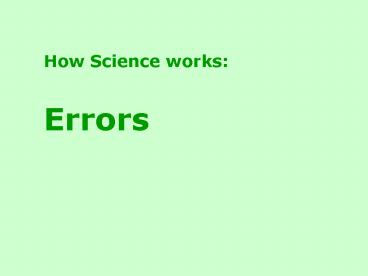How Science works : Errors - PowerPoint PPT Presentation
1 / 20
Title:
How Science works : Errors
Description:
Do you look from above the meniscus? Faulty technique. Example 2 ... Or do you look level with the meniscus? Answer: level. Faulty equipment. Example ... – PowerPoint PPT presentation
Number of Views:52
Avg rating:3.0/5.0
Title: How Science works : Errors
1
How Science works Errors
2
Learning Objectives You should learn
- About different types of errors,
- How to reduce them when you are doing your
practical work.
3
What is an error?
4
Types of errors
When reading scales, there are 2 main types of
error
- Random errors
- Systematic errors.
Lets look at some examples . . .
5
Random errors
- These may be due to
- human error
- a faulty technique
- or faulty equipment.
To reduce the error, take a lot of readings, and
then calculate the average (mean).
6
Human error
Example
Reading a burette
2.45ml or 3.55ml?
Correct volume 2.45ml
7
Faulty technique
Example 1
Measuring a volume
Which size measuring cylinder should you use to
measure 20ml?
Answer 25ml
8
Faulty technique
Example 2
Reading a burette
Do you look from above the meniscus?
9
Faulty technique
Example 2
Do you look from below the meniscus?
10
Faulty technique
Example 2
Or do you look level with the meniscus?
Answer level
11
Faulty equipment
Example
Which thermometer is correct?
12
Systematic errors
These errors cause readings to be shifted one
way (or the other) from the true reading.
Your results will be systematically wrong.
Lets look at some examples . . .
13
Systematic errors
Example 1 Suppose you are measuring with a ruler
If the ruler is wrongly calibrated, or if it
expands,
then all the readings will be too low (or all too
high)
14
Systematic errors
Example 2 If you have a parallax error
with your eye always too high
then you will get a systematic error
All your readings will be too high.
15
Systematic errors
A particular type of systematic error is called a
zero error.
Here is an example . . .
16
Zero errors
Example Look at this top-pan balance
It has a zero error.
There is nothing on it, but it is not reading
zero.
What effect do you think this will have on all
the readings?
17
Anomalous results
When you are doing your practical work, you may
get an odd or inconsistent or anomalous
reading. This may be due to a simple mistake in
reading a scale. The best way to identify an
anomalous result is to draw a graph. For example
. . .
18
Anomalous results
Look at this graph
Which result do you think may be anomalous?
A result like this should be taken again, to
check it.
19
In summary
- Human errors can be due to faulty technique.
- Parallax errors can be avoided.
- Anomalous results can be seen on a graph.
- Random errors can be reduced by taking many
readings, and then calculating the average (mean).
- Systematic errors, including zero errors, will
cause all your results to be wrong.
20
Learning Outcomes You should now
- Understand the effects of
- - Human error, including parallax error,
- - Random errors,
- - Systematic errors, including zero errors
- Be able to reduce these errors when doing your
practical work - Be able to identify anomalous results.































